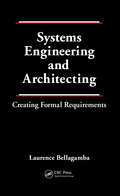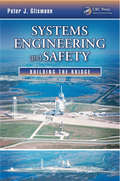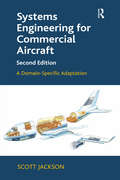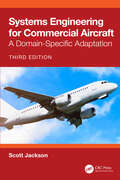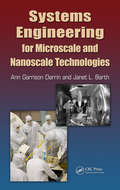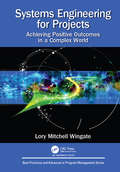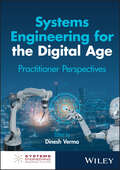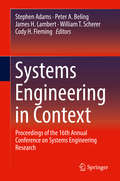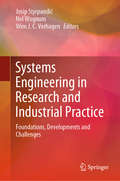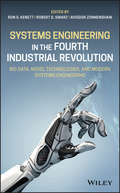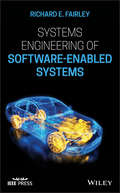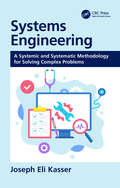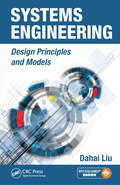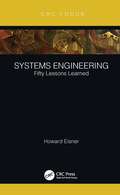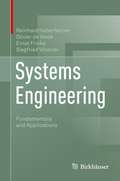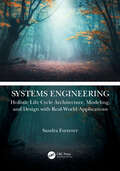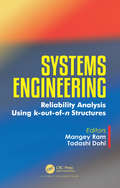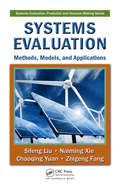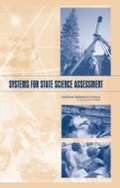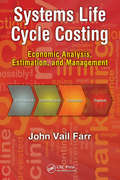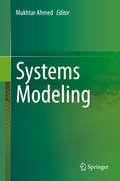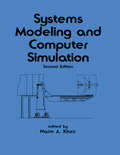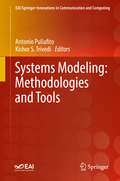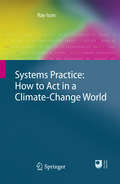- Table View
- List View
Systems Engineering and Architecting: Creating Formal Requirements
by Laurence BellagambaSystems Engineering and Architecting: Creating Formal Requirements presents formal requirements to help you accomplish key systems engineering and architecting activities more efficiently. The formal requirements-explicit, executable, verifiable instructions-explain how to model systems behavior, make decisions, establish natural language requirements, and improve your systems engineering and architecting processes.Each chapter opens with case studies and lessons learned, which supply the real-world context for the formal requirements. Topics covered include how to use fuzzy logic and agents to model uncertainty and how to make decisions when confronted with ambiguity. The book also clarifies the differences between architecting and systems engineering.Mathematical Tools for Systems Engineering and ArchitectingWritten in Mathematica (R), each formal requirement provides a tool or serves as the algorithm for a more efficient implementation in another form. All of the requirements are available as an open source library for anyone to use, improve upon, or add to. Worked examples, illustrations, and example surveys help you apply the requirements to your own systems. The book also lists heuristics to guide you in those systems engineering or architecting activities that cannot yet be formally stipulated.Bring More Consistency to Your Systems Development and ManagementAcknowledging that much of the practice remains an art, this book brings as much scientific rigor as possible to the tasks performed by systems engineers and architects. Written by a director of engineering who led systems engineering or architecting efforts for the Space Shuttle Program, Space Control Architecture Development, and others, this book shows you how to develop more consistent processes for large-scale systems.
Systems Engineering and Safety: Building the Bridge
by Peter J. GlismannSystems engineering principles are currently being applied to system safety best practices in several industries, as well as state and local governments. This book covers the payoff in both dollars and goodwill to the investment made in merging those two important and often neglected disciplines. It can be read, understood, and acted upon by the Chief Executive Officer of a multinational corporation, right down to the line manager of systems engineering or the technical professional in the safety department. The value in terms of cost savings, be it in the form of financial, human, or social capital, is clearly illustrated with real world examples.
Systems Engineering for Commercial Aircraft: A Domain-Specific Adaptation
by Scott JacksonThe key principle of systems engineering is that an aircraft should be considered as a whole and not as a collection of parts. Another principle is that the requirements for the aircraft and its subsystems emanate from a logical set of organized functions and from economic or customer-oriented requirements as well as the regulatory requirements for certification. The resulting process promises to synthesize and validate the design of aircraft which are higher in quality, better meet customer requirements and are most economical to operate. This book is more of a how to and a why to rather than a what to guide. It stresses systems engineering is an integrated technical-managerial process that can be adapted without sacrificing quality in which risk handling and management is a major part. It explains that the systems view applies to both the aircraft and the entire air transport system. The book emphasizes that system engineering is not an added layer of processes on top of the existing design processes; it is the glue that holds all the other processes together. The readership includes the aircraft industry, suppliers and regulatory communities, especially technical, program and procurement managers; systems, design and specialty engineers (human factors, reliability, safety, etc.); students of aeronautical and systems engineering and technical management; and government agencies such as FAA and JAA.
Systems Engineering for Commercial Aircraft: A Domain-Specific Adaptation
by Scott JacksonThe key principle of systems engineering is that an aircraft should be considered as a whole and not as a collection of parts. Another principle is that the requirements for the aircraft and its subsystems emanate from a logical set of organized functions and from economic or customer-oriented requirements as well as the regulatory requirements for certification. The resulting process promises to synthesize and validate the design of aircraft which are higher in quality, better meet customer requirements and are most economical to operate. This book is more of a how to and a why to rather than a what to guide. It stresses systems engineering is an integrated technical-managerial process that can be adapted without sacrificing quality in which risk handling and management is a major part. It explains that the systems view applies to both the aircraft and the entire air transport system. The book emphasizes that system engineering is not an added layer of processes on top of the existing design processes; it is the glue that holds all the other processes together. The readership includes the aircraft industry, suppliers and regulatory communities, especially technical, program and procurement managers; systems, design and specialty engineers (human factors, reliability, safety, etc.); students of aeronautical and systems engineering and technical management; and government agencies such as FAA and JAA.
Systems Engineering for Commercial Aircraft: A Domain-Specific Adaptation
by Scott JacksonSystems-engineered aircraft are designed to transport passengers safely, ensuring all components work together seamlessly. This book explores the concept of aircraft as a complex system, including humans, with safety as a crucial aspect. By prioritizing safety and quality, fewer fatalities can be achieved, leading to efficient, reliable, and safe aircraft for passengers and crew.Systems Engineering for Commercial Aircraft: A Domain-Specific Adaptation, Third Edition focuses on Deming's definition of quality, its methods, and the benefits it brings, which were not covered in the previous edition. The Risk chapter will also be expanded to include discussions on Risk Denial, its consequences, and strategies to avoid it. A detailed examination of resilience will be provided, highlighting how it enables an aircraft to prevent, endure, and recover from disruptions such as bird strikes. The book will explore the proactive and reactive aspects of resilience, how a system, like an aircraft, can be defined by its functions, and how an aircraft's design should prioritize the needs of various stakeholders, including passengers, regulatory agencies, and other relevant parties.The primary audience for this book consists of major aircraft companies engaged in advanced design, aeronautical engineers, and systems engineers.
Systems Engineering for Microscale and Nanoscale Technologies
by M. Ann Garrison Darrin Janet L. BarthTo realize the full potential of micro- and nanoscale devices in system building, it is critical to develop systems engineering methodologies that successfully integrate stand-alone, small-scale technologies that can effectively interface with the macro world. So how do we accomplish this?Systems Engineering for Microscale and Nanoscale Technologie
Systems Engineering for Projects: Achieving Positive Outcomes in a Complex World (Best Practices in Portfolio, Program, and Project Management)
by Lory Mitchell WingateSystems engineering has been applied to some of the most important projects of our time, including those that have helped humanity explore the world and the universe, expand our technical abilities, and enhance the quality of human life. Without formal training in systems engineering, the discipline is often difficult to understand and apply, and its use within projects is often confusing. Systems Engineering for Projects: Achieving Positive Outcomes in a Complex World provides an approach that utilizes a combination of the most effective processes from both project management and systems engineering disciplines in a simplified and straightforward manner. The processes described in the book are lightweight, flexible, and tailorable. They provide the shortest path to success in projects across the entire project life cycle, from research to operations, and from simple to the most complex. The book also addresses how this methodology can be used in a continually adapting and changing world, as projects span disciplines and become even more interconnected across all areas of human existence. Each chapter includes diagrams, templates, summary lists, a case study, and a thought-provoking question and answer section that assists readers in immediate application of the material to their own projects. The book is a project manager’s resource for understanding how to directly apply essential processes to projects in a way that increases the probability of achieving success. It is a comprehensive, go-to manual on the application of systems engineering processes to projects of all types and complexity.
Systems Engineering for the Digital Age: Practitioner Perspectives
by Dinesh VermaSystems Engineering for the Digital Age Comprehensive resource presenting methods, processes, and tools relating to the digital and model-based transformation from both technical and management views Systems Engineering for the Digital Age: Practitioner Perspectives covers methods and tools that are made possible by the latest developments in computational modeling, descriptive modeling languages, semantic web technologies, and describes how they can be integrated into existing systems engineering practice, how best to manage their use, and how to help train and educate systems engineers of today and the future. This book explains how digital models can be leveraged for enhancing engineering trades, systems risk and maturity, and the design of safe, secure, and resilient systems, providing an update on the methods, processes, and tools to synthesize, analyze, and make decisions in management, mission engineering, and system of systems. Composed of nine chapters, the book covers digital and model-based methods, digital engineering, agile systems engineering, improving system risk, and more, representing the latest insights from research in topics related to systems engineering for complicated and complex systems and system-of-systems. Based on validated research conducted via the Systems Engineering Research Center (SERC), this book provides the reader a set of pragmatic concepts, methods, models, methodologies, and tools to aid the development of digital engineering capability within their organization. Systems Engineering for the Digital Age: Practitioner Perspectives includes information on: Fundamentals of digital engineering, graphical concept of operations, and mission and systems engineering methods Transforming systems engineering through integrating M&S and digital thread, and interactive model centric systems engineering The OODA loop of value creation, digital engineering measures, and model and data verification and validation Digital engineering testbed, transformation, and implications on decision making processes, and architecting tradespace analysis in a digital engineering environment Expedited systems engineering for rapid capability and learning, and agile systems engineering framework Based on results and insights from a research center and providing highly comprehensive coverage of the subject, Systems Engineering for the Digital Age: Practitioner Perspectives is written specifically for practicing engineers, program managers, and enterprise leadership, along with graduate students in related programs of study.
Systems Engineering in Context: Proceedings of the 16th Annual Conference on Systems Engineering Research
by William T. Scherer James H. Lambert Stephen Adams Peter A. Beling Cody H. FlemingThis volume chronicles the 16th Annual Conference on System Engineering Research (CSER) held on May 8-9, 2018 at the University of Virginia, Charlottesville, Virginia, USA. The CSER offers researchers in academia, industry, and government a common forum to present, discuss, and influence systems engineering research. It provides access to forward‐looking research from across the globe, by renowned academicians as well as perspectives from senior industry and government representatives. Co‐founded by the University of Southern California and Stevens Institute of Technology in 2003, CSER has become the preeminent event for researchers in systems engineering across the globe. Topics include though are not limited to the following: Systems in context: · Formative methods: requirements · Integration, deployment, assurance · Human Factors · Safety and Security Decisions/ Control & Design; Systems Modeling: · Optimization, Multiple Objectives, Synthesis · Risk and resiliency · Collaborative autonomy · Coordination and distributed decision-making Prediction: · Prescriptive modeling; state estimation · Stochastic approximation, stochastic optimization and control Integrative Data engineering: · Sensor Management · Design of Experiments
Systems Engineering in Research and Industrial Practice: Foundations, Developments and Challenges
by Josip Stjepandić Nel Wognum Wim J. C. VerhagenThis book details the foundations, new developments and methods, applications, and current challenges of systems engineering (SE). It provides key insights into SE as a concept and as an approach based on the holistic view on the entire lifecycle (requirements, design, production, and exploitation) of complex engineering systems, such as spacecraft, aircraft, power plants, and ships.Written by leading international experts, the book describes the achievements of the holistic, transdisciplinary approach of SE as state of the art both in research and practice using case study examples from originating at universities and companies such as Airbus, BAE Systems, BMW, Boeing, and COMAC.The reader obtains a comprehensive insight into the still existing challenges of the concept of SE today and the various forms in which SE is applied in a variety of areas.
Systems Engineering in the Fourth Industrial Revolution: Big Data, Novel Technologies, and Modern Systems Engineering
by Ron S KenettAn up-to-date guide for using massive amounts of data and novel technologies to design, build, and maintain better systems engineering Systems Engineering in the Fourth Industrial Revolution: Big Data, Novel Technologies, and Modern Systems Engineering offers a guide to the recent changes in systems engineering prompted by the current challenging and innovative industrial environment called the Fourth Industrial Revolution—INDUSTRY 4.0. This book contains advanced models, innovative practices, and state-of-the-art research findings on systems engineering. The contributors, an international panel of experts on the topic, explore the key elements in systems engineering that have shifted towards data collection and analytics, available and used in the design and development of systems and also in the later life-cycle stages of use and retirement. The contributors address the issues in a system in which the system involves data in its operation, contrasting with earlier approaches in which data, models, and algorithms were less involved in the function of the system. The book covers a wide range of topics including five systems engineering domains: systems engineering and systems thinking; systems software and process engineering; the digital factory; reliability and maintainability modeling and analytics; and organizational aspects of systems engineering. This important resource: Presents new and advanced approaches, methodologies, and tools for designing, testing, deploying, and maintaining advanced complex systems Explores effective evidence-based risk management practices Describes an integrated approach to safety, reliability, and cyber security based on system theory Discusses entrepreneurship as a multidisciplinary system Emphasizes technical merits of systems engineering concepts by providing technical models Written for systems engineers, Systems Engineering in the Fourth Industrial Revolution offers an up-to-date resource that contains the best practices and most recent research on the topic of systems engineering.
Systems Engineering of Software-Enabled Systems (Wiley - IEEE)
by Richard E. FairleyA comprehensive review of the life cycle processes, methods, and techniques used to develop and modify software-enabled systems Systems Engineering of Software-Enabled Systems offers an authoritative review of the most current methods and techniques that can improve the links between systems engineering and software engineering. The author—a noted expert on the topic—offers an introduction to systems engineering and software engineering and presents the issues caused by the differences between the two during development process. The book reviews the traditional approaches used by systems engineers and software engineers and explores how they differ. The book presents an approach to developing software-enabled systems that integrates the incremental approach used by systems engineers and the iterative approach used by software engineers. This unique approach is based on developing system capabilities that will provide the features, behaviors, and quality attributes needed by stakeholders, based on model-based system architecture. In addition, the author covers the management activities a systems engineer or software engineer must engage in to manage and lead the technical work to be done. This important book: Offers an approach to improving the process of working with systems engineers and software engineers Contains information on the planning and estimating, measuring and controlling, managing risk, and organizing and leading systems engineering teams Includes a discussion of the key points of each chapter and exercises for review Suggests numerous references that provide additional readings for development of software-enabled physical systems Provides two case studies as running examples throughout the text Written for advanced undergraduates, graduate students, and practitioners, Systems Engineering of Software-Enabled Systems offers a comprehensive resource to the traditional and current techniques that can improve the links between systems engineering and software engineering.
Systems Engineering: A Systemic and Systematic Methodology for Solving Complex Problems
by Joseph Eli KasserThis book will change the way you think about problems. It focuses on creating solutions to all sorts of complex problems by taking a practical, problem-solving approach. It discusses not only what needs to be done, but it also provides guidance and examples of how to do it. The book applies systems thinking to systems engineering and introduces several innovative concepts such as direct and indirect stakeholders and the Nine-System Model, which provides the context for the activities performed in the project, along with a framework for successful stakeholder management. A list of the figures and tables in this book is available at https://www.crcpress.com/9781138387935. FEATURES • Treats systems engineering as a problem-solving methodology • Describes what tools systems engineers use and how they use them in each state of the system lifecycle • Discusses the perennial problem of poor requirements, defines the grammar and structure of a requirement, and provides a template for a good imperative construction statement and the requirements for writing requirements • Provides examples of bad and questionable requirements and explains the reasons why they are bad and questionable • Introduces new concepts such as direct and indirect stakeholders and the Shmemp! • Includes the Nine-System Model and other unique tools for systems engineering
Systems Engineering: Design Principles and Models
by Dahai LiuFor the past several decades, systems engineering has grown rapidly in its scope and application and shown significant benefits for the design of large, complex systems. However, current systems engineering textbooks are either too technical or at a high conceptual level. Written by an expert with more than ten years of teaching experience, Systems Engineering: Design Principles and Models not only gives students exposure to the concepts of systems and systems engineering, but also provides enough technical expertise for them to immediately use and apply what they learn. The book covers systems and systems engineering, systems methods, models, and analytical techniques as well as systems management and control methods. It discusses systems concepts, emphasizing system life cycle, and includes coverage of systems design processes and the major activities involved. It offers hands-on exercises after each chapter, giving students a solid understanding of system requirements, and uses a software package (CORE) to introduce the requirement management process. Designed for readers with a wide range of backgrounds, the book enables students to learn about systems and systems engineering, and, more specifically, to be able to use and apply the models and methods in the systems engineering field. The author has integrated feedback from students with materials used in teaching for many years, making the book especially approachable to non-engineering students with no prior exposure to this subject. Engineering students, on the other hand, will also benefit from the clear, concise coverage this book provides as well as the relevant analysis models and techniques.
Systems Engineering: Fifty Lessons Learned (CRC Press Focus Shortform Book Program #59)
by Howard EisnerThe author has spent approximately 50 years in the field of systems engineering. This Focus book provides a "looking back" at his 50-year run and the lessons he learned and would like to share with other engineers, so they can use these lessons in their day-to-day work in systems engineering and related fields. The book is written from a systems engineering perspective. It offers 50 lessons learned working for a variety of different companies, which can be used across many other engineering fields. The book will be of interested to students and engineers across many fields, as well as students and engineers working in business and management fields.
Systems Engineering: Fundamentals and Applications (Engineering Systems Ser.)
by Reinhard Haberfellner Olivier de Weck Ernst Fricke Siegfried VössnerThis translation brings a landmark systems engineering (SE) book to English-speaking audiences for the first time since its original publication in 1972. For decades the SE concept championed by this book has helped engineers solve a wide variety of issues by emphasizing a top-down approach. Moving from the general to the specific, this SE concept has situated itself as uniquely appealing to both highly trained experts and anybody managing a complex project. Until now, this SE concept has only been available to German speakers. By shedding the overtly technical approach adopted by many other SE methods, this book can be used as a problem-solving guide in a great variety of disciplines, engineering and otherwise.By segmenting the book into separate parts that build upon each other, the SE concept’s accessibility is reinforced. The basic principles of SE, problem solving, and systems design are helpfully introduced in the first three parts. Once the fundamentals are presented, specific case studies are covered in the fourth part to display potential applications. Then part five offers further suggestions on how to effectively practice SE principles; for example, it not only points out frequent stumbling blocks, but also the specific points at which they may appear. In the final part, a wealth of different methods and tools, such as optimization techniques, are given to help maximize the potential use of this SE concept.Engineers and engineering students from all disciplines will find this book extremely helpful in solving complex problems. Because of its practicable lessons in problem-solving, any professional facing a complex project will also find much to learn from this volume.
Systems Engineering: Holistic Life Cycle Architecture Modeling and Design with Real-World Applications
by Sandra FurtererThis book provides a guide for systems engineering modeling and design. It focuses on the design life cycle with tools and application-based examples of how to design a system, focusing on incorporating systems principles and tools to ensure system integration. It provides product-based and service system examples to understand the models, tools, and activities to be applied to design and implement a system. The first section explains systems principles, models, and architecture for systems engineering, lifecycle models, and the systems architecture. Further sections explain systems design, development, and deployment life cycle with applications and tools and advanced systems engineering topics. Features: Focuses on model-based systems engineering and describes the architecture of the systems design models. Uses real-world examples to corroborate different and disparate systems engineering activities. Describes and applies the Vee systems engineering design methodology, with cohesive examples and applications of designing systems. Discusses culture change and the skills people need to design and integrate systems. Shows detailed and cohesive examples of the systems engineering tools throughout the systems engineering life cycle. This book is aimed at graduate students and researchers in systems engineering, modeling and simulation, any major engineering discipline, industrial engineering, and technology.
Systems Engineering: Reliability Analysis Using k-out-of-n Structures
by Tadashi Dohi Mangey RamA substantial amount of research has been conducted on consecutive k-out-of-n and related reliability systems over the past four decades. These systems have been used to model various engineering systems such as the microwave stations of telecoms network, oil pipeline systems, and vacuum systems in an electron accelerator. As such, studies of reliability properties of consecutive k-out-of-n structures have attracted significant attention from both theoretical and practical approaches. In the modern era of technology, the redundancies are employed in the various industrial systems to prevent them from failure/sudden failure or to recover from failures. This book is meant to provide knowledge and help engineers and academicians in understanding reliability engineering by using k-out-of-n structures. The material is also targeted at postgraduate or senior undergraduate students pursuing reliability engineering.
Systems Evaluation: Methods, Models, and Applications (Systems Evaluation, Prediction, and Decision-Making)
by Sifeng Liu Naiming Xie Chaoqing Yuan Zhigeng FangA book in the Systems Evaluation, Prediction, and Decision-Making Series, Systems Evaluation: Methods, Models, and Applications covers the evolutionary course of systems evaluation methods, clearly and concisely. Outlining a wide range of methods and models, it begins by examining the method of qualitative assessment. Next, it describes the process
Systems For State Science Assessment
by Committee on Test Design for K-12 Science AchievementIn response to the No Child Left Behind Act of 2001 (NCLB), Systems for State Science Assessment explores the ideas and tools that are needed to assess science learning at the state level. This book provides a detailed examination of K-12 science assessment: looking specifically at what should be measured and how to measure it. Along with reading and mathematics, the testing of science is a key component of NCLB—it is part of the national effort to establish challenging academic content standards and develop the tools to measure student progress toward higher achievement. The book will be a critical resource for states that are designing and implementing science assessments to meet the 2007-2008 requirements of NCLB. In addition to offering important information for states, Systems for State Science Assessment provides policy makers, local schools, teachers, scientists, and parents with a broad view of the role of testing and assessment in science education.
Systems Life Cycle Costing: Economic Analysis, Estimation, and Management (Engineering Management)
by John V. FarrAlthough technology and productivity has changed much of engineering, many topics are still taught in very similarly to how they were taught in the 70s. Using a new approach to engineering economics, Systems Life Cycle Costing: Economic Analysis, Estimation, and Management presents the material that a modern engineer must understand to work as a pr
Systems Modeling
by Mukhtar AhmedAchieving food security and economic developmental objectives in the face of climate change and rapid population growth requires systems modelling approaches, for example in the design of sustainable agriculture farming systems. Such approaches increase our understanding of system responses to different soil and climatic conditions, and provide insights into the effects of various variable climate change scenarios, providing valuable information for decision-makers. Further, in the agricultural sector, systems modelling can help optimise crop management and adaptation measures to boost productivity under variable climatic conditions. Presenting key outcomes from crop models used in agricultural systems this book is a valuable resource for professionals interested in using modelling approaches to manage the growth and improve the quality of various crops.
Systems Modeling and Computer Simulation (Electrical Engineering And Electronics Ser. #No. 46)
by Naim A. KheirThis second edition describes the fundamentals of modelling and simulation of continuous-time, discrete time, discrete-event and large-scale systems. Coverage new to this edition includes: a chapter on non-linear systems analysis and modelling, complementing the treatment of of continuous-time and discrete-time systems and a chapter on the computer animation and visualization of dynamical systems motion.
Systems Modeling: Methodologies and Tools (EAI/Springer Innovations in Communication and Computing)
by Kishor S. Trivedi Antonio PuliafitoThis book covers ideas, methods, algorithms, and tools for the in-depth study of the performance and reliability of dependable fault-tolerant systems. The chapters identify the current challenges that designers and practitioners must confront to ensure the reliability, availability, and performance of systems, with special focus on their dynamic behaviors and dependencies. Topics include network calculus, workload and scheduling; simulation, sensitivity analysis and applications; queuing networks analysis; clouds, federations and big data; and tools. This collection of recent research exposes system researchers, performance analysts, and practitioners to a spectrum of issues so that they can address these challenges in their work.
Systems Practice: How to Act in a Climate Change World
by Ray IsonIt is now accepted that humans are changing the climate of the Earth and this is the most compelling amongst a long litany of reasons as to why, collectively, we have to change our ways of thinking and acting. Most people now recognise that we have to be capable of adapting quickly as new and uncertain circumstances emerge: this capability will need to exist at personal, group, community, regional, national and international levels, all at the same time. Systems Practice is structured into four parts. Part I introduces the societal need to move towards a more systemic and adaptive governance against the backdrop of human-induced climate change. Part II unpacks what is involved in systems practice by means of a juggler metaphor; examining situations where systems thinking offers useful understanding and opportunities for change. Part III identifies the main factors that constrain the uptake of systems practice and makes the case for innovation in practice by means of systemic inquiry, systemic action research and systemic intervention. The book concludes with Part IV, which critically examines how systems practice is, or might be, utilised at different levels from the personal to the societal. The development of our capabilities to think and act systemically is an urgent priority and Systems Practice aims to show how to do systems thinking and translate that thinking into praxis (theory informed practical action) which will be welcomed by those managing in situations of complexity and uncertainty across all domains of professional and personal concern.
